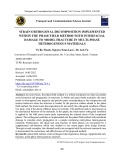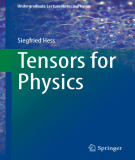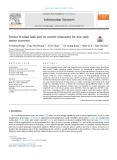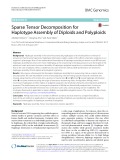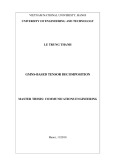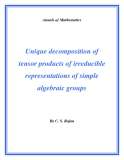
Tensor decomposition
-
In recent times, the phase field method is a robust simulation tool that can predict crack formation and propagation in structures. In brittle and quasi-brittle materials, the strain tensor is decomposed into negative and positive parts corresponding to the compression and tension behaviors when the structure is loaded.
 14p
14p  viwalton
viwalton
 02-07-2024
02-07-2024
 1
1
 1
1
 Download
Download
-
Part 1 of ebook "Tensors for Physics" provides readers with content including: a primer on vectors and tensors; symmetry of second rank tensors, cross product; epsilon-tensor; symmetric second rank tensors; summary - decomposition of second rank tensors; fields, spatial differential operators; integration of fields;...
 166p
166p  lytamnguyet
lytamnguyet
 04-08-2023
04-08-2023
 4
4
 3
3
 Download
Download
-
The recent popular tensor tubal rank, defined based on tensor singular value decomposition (t-SVD), yields promising results. However, its framework is applicable only to three-way tensors and lacks the flexibility necessary tohandle different correlations along different modes.
 20p
20p  guernsey
guernsey
 28-12-2021
28-12-2021
 12
12
 0
0
 Download
Download
-
Assembly of haplotypes polyploid organisms is considerably more difficult than in the case of diploids. Hence, scalable and accurate schemes with provable performance are desired for haplotype assembly of both diploid and polyploid organisms.
 15p
15p  vibeauty
vibeauty
 23-10-2021
23-10-2021
 9
9
 0
0
 Download
Download
-
A tensor is a multi-dimensional array and often considered as a generalization of a matrix. As a result, tensor representation gives a natural description of multi-dimensional data and hence tensor decomposition becomes a useful tool to analyze high-dimensional data. Moreover, tensor decomposition brings new opportunities for uncovering hidden and new values in the data.
 24p
24p  tamynhan0
tamynhan0
 04-07-2020
04-07-2020
 19
19
 2
2
 Download
Download
-
In this thesis, motivated by the advantages of the generalized minimumnoise subspace (GMNS) method, recently proposed for array processing, we proposedtwo algorithms for principal subspace analysis (PSA) and two algorithms for tensor de-composition using parallel factor analysis (PARAFAC) and higher-order singular valuedecomposition (HOSVD).
 68p
68p  tamynhan0
tamynhan0
 04-07-2020
04-07-2020
 7
7
 2
2
 Download
Download
-
In conventional diffusion tensor imaging (DTI) based on magnetic resonance data, each voxel is assumed to contain a single component having diffusion properties that can be fully represented by a single tensor. Even though this assumption can be valid in some cases, the general case involves the mixing of components, resulting in significant deviation from the single tensor model. Hence, a strategy that allows the decomposition of data based on a mixture model has the potential of enhancing the diagnostic value of DTI.
 13p
13p  kethamoi1
kethamoi1
 20-11-2019
20-11-2019
 11
11
 1
1
 Download
Download
-
(bq) part 1 book "object detection and recognition in digital images" has contents: object detection and tracking, object recognition, recognition based on tensor decompositions, recognition from deformable models, template based recognition, template based recognition.
 194p
194p  bautroibinhyen19
bautroibinhyen19
 02-03-2017
02-03-2017
 29
29
 2
2
 Download
Download
-
We show that a tensor product of irreducible, finite dimensional representations of a simple Lie algebra over a field of characteristic zero determines the individual constituents uniquely. This is analogous to the uniqueness of prime factorisation of natural numbers. 1. Introduction 1.1. Let g be a simple Lie algebra over C. The main aim of this paper is to prove the following unique factorisation of tensor products of irreducible, finite dimensional representations of g:
 23p
23p  tuanloccuoi
tuanloccuoi
 04-01-2013
04-01-2013
 47
47
 6
6
 Download
Download
-
ICA by Tensorial Methods One approach for estimation of independent component analysis (ICA) consists of using higher-order cumulant tensor. Tensors can be considered as generalization of matrices, or linear operators. Cumulant tensors are then generalizations of the covariance matrix. The covariance matrix is the second-order cumulant tensor, and the fourth order tensor is defined by the fourth-order cumulants cum(xi xj xk xl ). For an introduction to cumulants, see Section 2.7. As explained in Chapter 6, we can use the eigenvalue decomposition of the covariance matrix to whiten the data.
 9p
9p  khinhkha
khinhkha
 29-07-2010
29-07-2010
 76
76
 4
4
 Download
Download
CHỦ ĐỀ BẠN MUỐN TÌM








